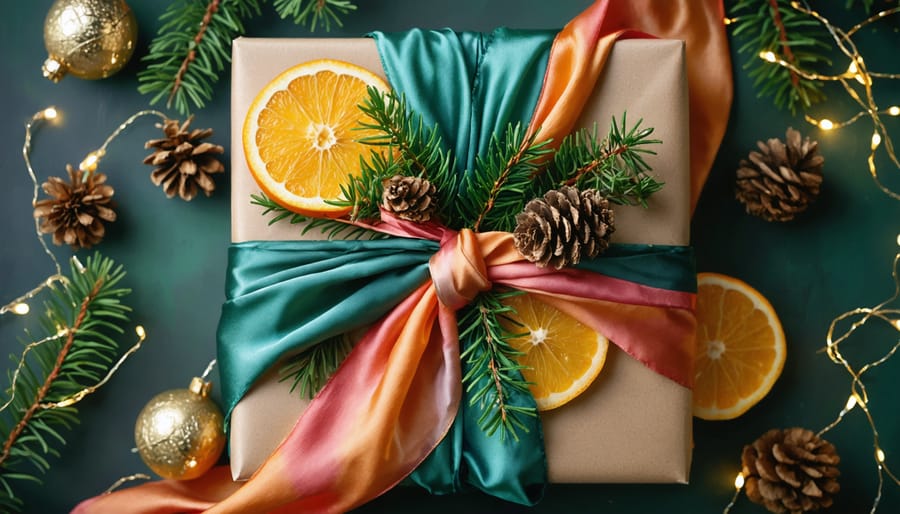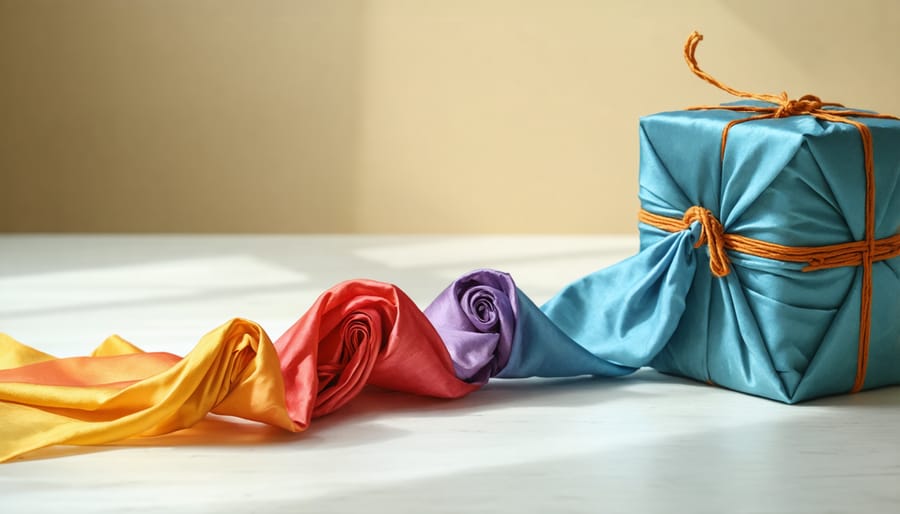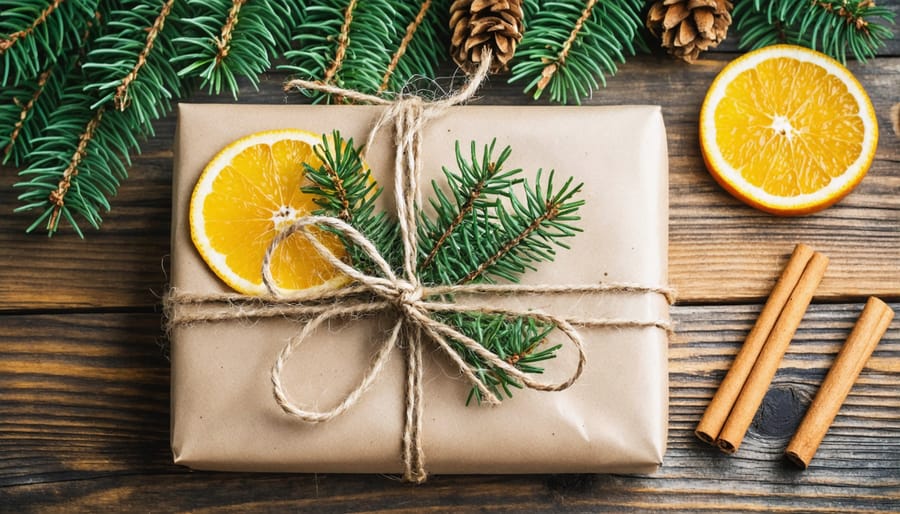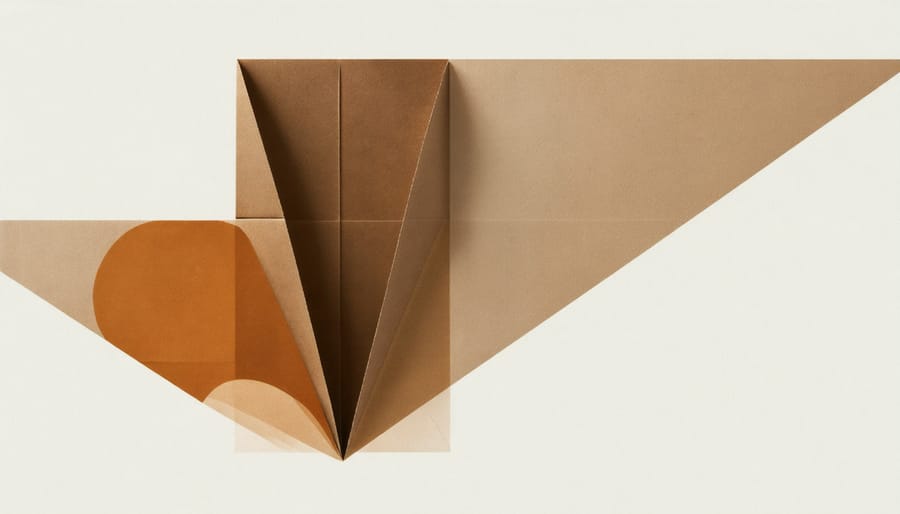
Transform your gift-giving impact this holiday season by replacing traditional wrapping paper with stylish, sustainable alternatives that elevate both your presents and the planet. Wrap gifts in vibrant silk scarves that become part of the present, create stunning packages with Japanese-inspired furoshiki fabric wrapping, or repurpose old maps and vintage sheet music for an artistic touch. These thoughtful wrapping choices not only reduce waste but add an extra layer of meaning to your eco-friendly holiday celebrations.
Whether you’re reaching for yesterday’s newspaper, crafting with brown kraft paper and twine, or transforming children’s artwork into memorable gift wrap, sustainable wrapping isn’t just about being environmentally conscious—it’s about creating a more meaningful exchange. Each carefully wrapped package tells a story, transforms would-be waste into beauty, and inspires others to rethink holiday traditions in ways that honor both celebration and sustainability.
Eco-Friendly Materials You Already Have at Home
From Kitchen to Wrapping Station
You’d be amazed at the gift-wrapping treasures hiding in your kitchen and shopping bags! I discovered this eco-friendly hack last Christmas when I ran out of wrapping paper on Christmas Eve. Now, I actually prefer these sustainable alternatives to store-bought wrap.
Kraft paper, like those sturdy paper grocery bags, creates a beautiful rustic look. Simply cut along the seams to create flat sheets, then smooth out any creases with a warm iron. The natural brown color serves as a perfect canvas for festive decorations or hand-drawn designs.
Newspaper offers another creative option, especially the Sunday comics for children’s gifts. For a more sophisticated look, use the black and white sections and dress them up with natural twine and evergreen sprigs. Pro tip: Asian language newspapers create an especially artistic effect!
Don’t toss those paper grocery bags from your last shopping trip. Turn them inside out to reveal a clean, kraft-paper surface perfect for wrapping. The thick paper holds crisp corners beautifully and stands up to handling better than traditional gift wrap.
Fabric Finds for Furoshiki
Imagine transforming a beautiful vintage scarf into an elegant gift wrap that becomes part of the present itself – that’s the magic of furoshiki, the Japanese art of fabric wrapping. I discovered this technique during my zero-waste journey, and it’s completely changed how I present gifts to loved ones.
The beauty of furoshiki lies in its versatility. Tea towels, silk scarves, bandanas, and even repurposed clothing can create stunning wrapped packages. My personal favorite is using vintage scarves from thrift stores – they add a story to each gift and often cost less than traditional wrapping paper.
Getting started is surprisingly simple. Square fabrics work best, but don’t worry if yours isn’t perfect. The basic technique involves centering your gift on the fabric, bringing opposite corners together, and tying them in a knot. For added flair, try incorporating decorative knots or fabric flowers made from the excess material.
Pro tip: Keep an eye out for fabric remnants at craft stores or upcycle old bed sheets by cutting them into squares. Once your recipient unwraps their gift, they can either keep the fabric or return it for your next wrapping adventure.


Natural Decorative Elements
Botanical Beauty
Transform your gifts into botanical works of art by incorporating elements from nature. Just as you might gather natural holiday decorations for your home, these same treasures can elevate your gift wrapping to new heights. I love collecting dried hydrangeas from my garden, which add a delicate, vintage touch when tucked into twine or ribbon. Pine cones, whether left natural or lightly dusted with eco-friendly glitter, create stunning focal points on packages. Fresh evergreen sprigs not only look beautiful but fill the room with that magical holiday scent. Try mixing different textures – pair soft lamb’s ear leaves with sturdy pine cones, or combine delicate dried lavender with robust eucalyptus stems. The best part? These natural embellishments can be composted or reused in other craft projects afterward. Just remember to forage responsibly and only take what you need from nature’s bounty.
Aromatic Additions
Transform your sustainably wrapped gifts into sensory delights by incorporating natural aromatics that engage both sight and smell. I love adding dried orange slices, which bring a pop of color and a subtle citrus scent that instantly evokes holiday memories. Simply string them together with twine or tuck them under ribbons made from natural materials.
Cinnamon sticks are another wonderful addition that doubles as both decoration and fragrance. Bundle three or four sticks together with twine and attach them to your package for a rustic touch that fills the room with warm, spicy notes. For an extra special touch, pair them with fresh rosemary sprigs or dried lavender stems.
Fresh herbs like sage, thyme, and bay leaves not only smell amazing but also add beautiful natural greenery to your packages. Try creating small bouquets or tucking individual sprigs under twine bow. These aromatic additions are especially lovely when paired with kraft paper or fabric wrapping, creating an eco-friendly presentation that delights multiple senses and can be composted or reused after gifting.
Creative Techniques for Sustainable Wrapping
No-Tape Folding Methods
Remember how our grandmothers used to create perfectly wrapped presents without a single piece of tape? Those traditional Japanese-inspired folding techniques are making a comeback, and they’re perfect for our sustainable wrapping journey! I discovered these methods last year, and they’ve completely transformed my gift-wrapping game.
The most versatile technique is the diagonal fold method. Start by placing your gift diagonally on your wrapping material. Bring the bottom corner up over the gift, then fold the sides in to create clean edges. Finally, tuck the top corner into the folded flaps – it’s like origami magic! For added security, you can slide a sprig of evergreen or a dried orange slice under the final fold.
Another favorite of mine is the box lid technique, which works beautifully for rectangular gifts. Fold your paper’s edges inward to create crisp corners, then wrap the ends like you’re creating envelope flaps. The final flap tucks neatly underneath, holding everything in place. I love using this method with sturdy paper like maps or brown kraft paper.
For oddly shaped gifts, try the pocket fold. Create a pocket by folding the paper in half, then insert your gift and fold the remaining sides inward, tucking them into each other. This method works particularly well with fabric wrapping, creating a sleek, modern look while staying completely secure.

Reusable Ribbon Alternatives
Let me share a little secret from my gift-wrapping adventures: the right ribbon can transform a simple package into something spectacular, and it doesn’t have to harm the environment! Instead of disposable plastic ribbons, I’ve discovered some beautiful alternatives that can be used again and again.
Natural fabric ribbons made from cotton, hemp, or linen are my go-to choices. They tie beautifully, hold their shape well, and can be ironed and stored for future use. I keep a collection of different widths and textures in neutral colors that work for any occasion.
For a rustic touch, twine made from jute or hemp adds organic charm to packages. I’ve found that baker’s twine in particular creates adorable candy-cane stripes perfect for holiday gifts. During autumn, I love using dried raffia – it adds a wonderful natural texture and can be composted after multiple uses.
One of my favorite discoveries has been vintage scarves and fabric strips. Not only do they make stunning bow alternatives, but the recipient can repurpose them as accessories or craft materials. You can even create lasting memories by using meaningful fabric pieces, like strips from old baby blankets or beloved clothes that have outlived their original purpose.
Remember to gently remove and roll your ribbons after gift-opening instead of cutting them. Store them in a dedicated box or wrapped around empty paper towel rolls to keep them crisp and ready for their next use.
Storage and Reuse Tips
Let me share a little secret that’s transformed my gift-wrapping game: creating a dedicated “gift wrap station” in my home. I use a large plastic storage container under my bed, but any cool, dry space will do. After each celebration, I carefully fold and store salvageable wrapping materials, smoothing out tissue paper and gently rolling ribbons around old paper towel tubes to prevent creasing.
Here’s my tried-and-true system for organizing your gift wrap supplies: Sort materials by type (paper, ribbons, gift bags) and store flat whenever possible. For wrapping paper rolls, try using an old garment bag or wrap them in kraft paper to protect them from dust and tears. Gift bags are incredibly easy to store – just flatten them and stack by size. Pro tip: tuck tissue paper inside the bags to save space and keep everything together.
Don’t forget to remove tape and labels before storing, and repair small tears with clear tape on the reverse side. I keep a small notebook listing what I have in storage, which helps avoid unnecessary purchases. Before each gifting season, I do a quick inventory and refresh my supplies as needed.
Remember to store your materials away from direct sunlight and moisture to prevent fading and damage. With proper care, most gift wrap items can be reused multiple times, making your sustainable choices even more impactful.
Embracing sustainable gift wrapping isn’t just about being environmentally conscious – it’s about creating meaningful moments while protecting our planet. When we choose eco-friendly wrapping options, we transform the act of meaningful gift-giving into a more thoughtful, creative experience. The beauty of reusable fabrics, recycled papers, and natural elements adds a personal touch that mass-produced wrapping paper simply can’t match.
By making the switch to sustainable alternatives, we’re not just wrapping presents – we’re wrapping them in intention, care, and environmental responsibility. Each beautifully wrapped gift becomes a testament to our commitment to both style and sustainability. Remember, the most precious gift we can give future generations is a healthier planet, and every small choice, including how we wrap our presents, contributes to that legacy.
So next time you’re preparing to wrap a gift, consider it an opportunity to express your creativity while making a positive impact. After all, there’s nothing more beautiful than a present wrapped with both love and respect for our environment.



